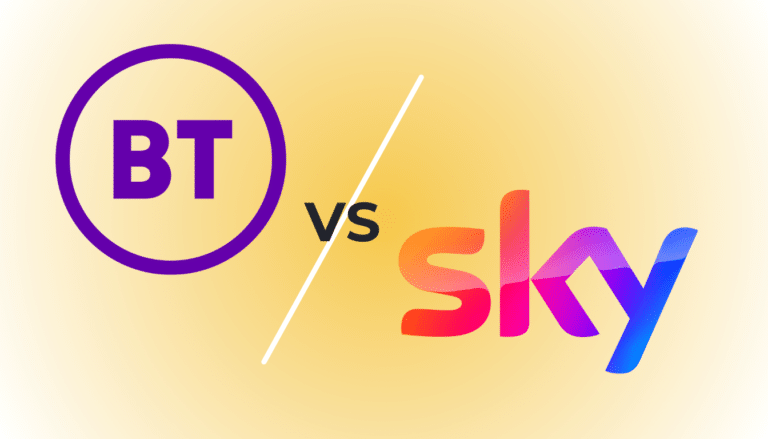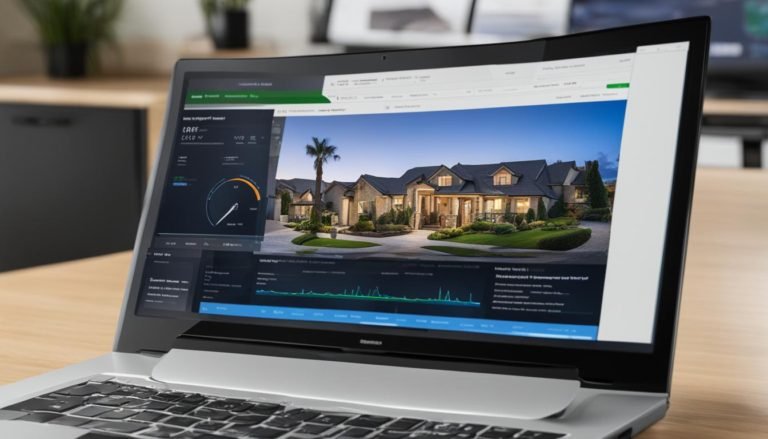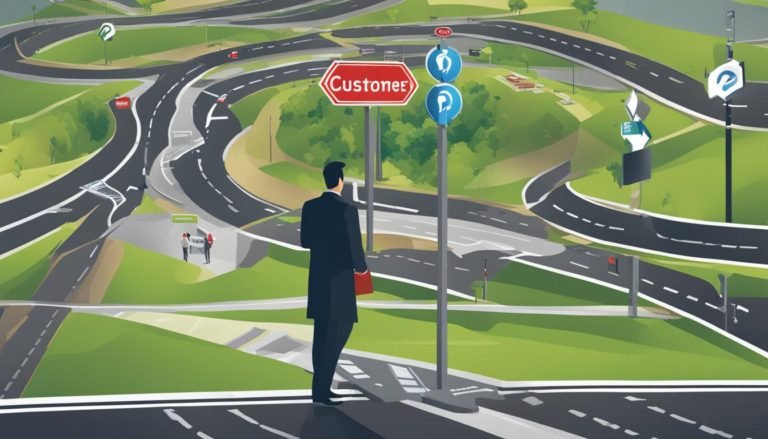In today’s digital age, reliable internet access is essential for both individuals and businesses. However, in the UK, there is a significant disparity between broadband connectivity in rural areas and urban hubs. Slow speeds and inadequate connections pose challenges for those living in less urban areas, hindering their ability to access online services and participate fully in the digital world.
Key Takeaways:
- Rural areas in the UK face challenges in accessing reliable broadband connections.
- Inadequate rural connectivity hampers economic growth and limits opportunities for individuals and businesses.
- The UK government has taken steps to improve rural broadband infrastructure, but more investment is needed.
- Community-driven initiatives and open access models can play a crucial role in closing the connectivity gap.
- Ensuring universal high-speed broadband in rural areas is vital for the future development of the UK.
The Impact of Insufficient Connectivity in Rural Areas
The digital divide between rural and urban areas in the UK is evident in the difference in broadband speeds. Slow internet speeds in rural areas hinder access to essential online services and limit opportunities for economic growth. Moreover, the lack of connectivity affects everyday tasks, such as communication, entertainment, and remote work. This disparity not only affects individuals but also impacts the overall development and potential of rural communities.
According to a report by Ofcom, nearly 677,000 UK homes in rural areas have broadband speeds of less than 10Mbps, which is inadequate for modern internet usage. This digital divide creates a significant disadvantage for rural communities, making it challenging to participate fully in today’s digital world. Businesses struggle to compete, individuals face limitations in accessing educational resources and healthcare services, and economic growth is stifled.
The lack of adequate connectivity in rural areas hampers many aspects of daily life. Basic tasks such as video streaming, online shopping, and video conferencing become frustrating and sometimes impossible. Rural communities miss out on the benefits of online education, telecommuting, and e-commerce, further exacerbating the divide between urban and rural areas. The digital divide perpetuates inequalities, limiting opportunities for social and economic advancement.

The Impact on Rural Businesses
Rural businesses, in particular, suffer from inadequate connectivity. Slow internet speeds hinder productivity, limit access to online markets, and increase operational costs. Businesses in rural areas struggle to compete with their urban counterparts, who have access to faster and more reliable broadband connections. The digital divide creates an uneven playing field, making it difficult for rural businesses to thrive and grow.
Government Initiatives to Improve Rural Connectivity
In response to the challenges of rural broadband connectivity, the UK government has implemented various initiatives aimed at improving internet access in rural areas. These initiatives primarily focus on enhancing broadband infrastructure and fostering rural connectivity.
One such initiative is the Local Full Fibre Networks challenge fund, which has a budget of £53 million. The fund aims to provide fiber connectivity in selected areas, allowing rural communities to access faster and more reliable broadband. While this initiative is a step in the right direction, the funding provided is limited compared to the cost of a national full-fiber rollout.
In addition to the challenge fund, the government has also prioritized the rollout of 5G networks. However, the success of 5G implementation relies heavily on the availability of strong fiber infrastructure. This highlights the importance of investing in fiber connectivity, as it serves as the backbone for future technological advancements in rural areas.
Government Initiatives Summary:
- The Local Full Fibre Networks challenge fund aims to provide fiber connectivity in selected areas.
- 5G rollout highlights the importance of investing in strong fiber infrastructure.
- Government initiatives focus on enhancing broadband infrastructure and fostering rural connectivity.
While these government initiatives are encouraging, they still fall short in addressing the connectivity issues faced by the most remote and difficult-to-reach rural areas. To bridge this gap, more comprehensive and targeted strategies are needed to ensure universal access to high-speed broadband across the UK.
| Government Initiative | Focus | Impact |
|---|---|---|
| Local Full Fibre Networks challenge fund | Providing fiber connectivity in selected areas | Improves broadband speeds and reliability for communities in targeted regions |
| 5G rollout | Emphasizing the importance of strong fiber infrastructure | Enables future technological advancements in rural areas through robust connectivity |
By combining government initiatives, community-driven solutions, and open access models, rural areas can overcome the challenges of limited connectivity and bridge the digital divide. This will not only benefit individuals and businesses in rural communities but also contribute to the overall economic growth and development of the country.
Community-Driven Solutions for Improved Connectivity
When it comes to improving rural broadband connectivity, local communities have taken matters into their own hands. A community-driven approach, supported by local authorities and volunteers, has proven to be a successful way to bridge the connectivity gap. One notable example is the Broadband for the Rural North (B4RN) initiative, which has connected thousands of homes to faster broadband through community collaboration. By investing in and installing their own fiber infrastructure, these communities have significantly improved internet access for residents.
Local authorities play a crucial role in supporting and facilitating community-driven solutions. They can provide resources, such as funding and permits, to enable the deployment of fiber networks. Additionally, local councils can learn from international examples, like Sweden, where collaborative efforts between local authorities and district groups have played a significant role in providing fiber connectivity. Taking a community-driven approach not only lowers costs but also fosters competition among service providers, leading to more affordable options for residents.
“Community-driven initiatives are a game-changer for rural connectivity. By empowering local communities and leveraging their collective resources, we can overcome the challenges of inadequate broadband access. These initiatives not only improve connectivity but also create stronger and more resilient communities.” – Local council representative
To illustrate the impact of community-driven solutions, consider the following table showcasing the success of B4RN in connecting homes to faster broadband:
| Year | Homes Connected | Volunteers |
|---|---|---|
| 2015 | 500 | 50 |
| 2016 | 1,000 | 100 |
| 2017 | 2,000 | 200 |
| 2018 | 3,000 | 250 |
By embracing a community-driven approach, rural areas can overcome the challenges of connectivity and unlock the full potential of their communities. With the support of local authorities and the dedication of volunteers, fiber deployment becomes more accessible and affordable, creating a brighter future for rural broadband connectivity in the UK.
Benefits of Community-Driven Solutions for Improved Connectivity
- Lower costs compared to traditional infrastructure deployments
- Increased competition among service providers, leading to more affordable options for residents
- Empowerment of local communities and stronger social connections
- Improved economic opportunities for rural businesses
- Enhanced quality of life for residents through better access to online services and resources
The Role of Open Access Models in Rural Connectivity
In order to bridge the digital divide in rural areas, an open access model can play a crucial role. This model, similar to what has been successfully implemented in Sweden, allows for multiple service providers to access and utilize the fiber network, creating a competitive environment and driving down costs for both providers and residents. By partnering with independent fiber providers, local councils can deploy fiber infrastructure without incurring the full cost, thus accelerating the deployment of fast and reliable broadband services in rural areas.
An open access model creates a level playing field for service providers, fostering competition and innovation. This not only ensures that residents in rural areas have a variety of options to choose from, but it also leads to improved quality of service and affordable pricing. With multiple service providers vying for customers, there is a greater incentive to invest in infrastructure and deliver high-speed broadband to even the most remote areas.
This open access approach also benefits rural communities by promoting collaboration and partnership. Instead of relying solely on government initiatives, local councils can work hand-in-hand with both public and private sector organizations to develop and maintain the fiber network. This collaborative effort helps build sustainable and resilient broadband infrastructure that can meet the evolving needs of rural communities in the long term.
The Benefits of an Open Access Model:
- Increased competition among service providers
- Lower costs for both providers and residents
- Improved quality of service and affordable pricing
- Collaboration between local councils, public sector, and private organizations
- Sustainable and resilient broadband infrastructure
| Service Provider | Download Speed | Upload Speed | Monthly Price (£) |
|---|---|---|---|
| Provider A | 100 Mbps | 50 Mbps | £30 |
| Provider B | 75 Mbps | 40 Mbps | £25 |
| Provider C | 50 Mbps | 30 Mbps | £20 |
Digital Strategies and Initiatives in Cornwall
In Cornwall, we have taken proactive steps to develop and implement digital strategies that address the challenges of rural digitization. Our integrated solutions aim to improve connectivity, enhance economic opportunities, and foster social inclusion in our rural communities.
One of our key initiatives is digital inclusion training, which equips residents with the necessary skills to navigate the digital landscape effectively. By providing free beginner sessions in libraries and community centers, we ensure that everyone has the opportunity to embrace and benefit from digital technologies.
Additionally, we have established digital hubs within communities, creating spaces where residents can access high-speed internet and engage in online activities. These hubs serve as catalysts for innovation, collaboration, and learning, enabling individuals and businesses to thrive in the digital age.
Furthermore, our commitment to e-health innovations has transformed healthcare delivery in Cornwall. Through the integration of technology and healthcare, we have improved access to medical services and empowered individuals to take control of their well-being. From telemedicine consultations to remote patient monitoring, our digital strategies prioritize the health and well-being of our rural communities.
In summary:
- We provide digital inclusion training to equip residents with essential digital skills.
- We establish digital hubs within communities to provide access to high-speed internet.
- We prioritize e-health innovations to enhance healthcare services in rural areas.
Through these initiatives, Cornwall is leading the way in bridging the digital divide and unlocking the potential of our rural communities. We believe that by embracing digital strategies, we can create a future where equal opportunities and connectivity are accessible to all.
The Social and Economic Impact of Rural Broadband
The provision of high-speed broadband in rural areas has a significant social and economic impact. Improved access to employment, healthcare, and community resources reduces the social isolation often experienced in remote areas. A study conducted by the University of Aberdeen found that individuals living in areas with reliable broadband reported higher levels of life satisfaction and well-being compared to those with limited connectivity. This suggests that the subsidization of superfast broadband in rural areas can contribute to a positive social return on investment, improving the overall quality of life for residents.
Furthermore, rural businesses can benefit greatly from improved broadband connectivity. With fast and reliable internet access, rural businesses can tap into online markets, expand their customer base, and compete on a level playing field with businesses in urban areas. This can lead to increased revenue, job creation, and economic growth in rural communities. A report by the Federation of Small Businesses estimates that improved connectivity could add £18.8 billion to the UK economy over the next five years, with rural businesses playing a vital role in this growth.
“We have seen a significant difference in our business since we got access to high-speed broadband,” says Sarah Thompson, owner of a rural bakery in Cornwall. “With faster internet, we were able to streamline our online ordering and delivery system, reaching customers who were previously out of our reach. It has allowed us to expand our business and create more employment opportunities for people in our community.”
Overall, investing in rural broadband infrastructure not only bridges the digital divide but also brings about positive social and economic outcomes. It improves the well-being of rural residents, boosts local businesses, and contributes to the growth and development of rural communities. To fully harness these benefits, continued investment and collaborative efforts between government, local authorities, and communities are essential.
Case Study: Superfast Cornwall
In our exploration of rural broadband connectivity, one noteworthy case study is Superfast Cornwall. This project, funded by the EU, BT, BDUK, and Cornwall Council, successfully rolled out fiber-based superfast broadband across Cornwall and the Isles of Scilly. The project aimed to connect 95% of homes and businesses in the region to fiber optic broadband, helping bridge the digital divide between rural and urban areas.
To achieve its goal, Superfast Cornwall focused not only on broadband infrastructure but also on digital inclusion. The project recognized that simply providing fast internet speeds was insufficient without ensuring that individuals and businesses had the skills to utilize and take advantage of the improved connectivity. As a result, Superfast Cornwall offered free beginner sessions in libraries and community centers, promoting digital literacy and empowering the local community.
The success of Superfast Cornwall highlights the importance of a holistic approach to rural broadband rollout. By investing in both broadband infrastructure and digital inclusion training, the project addressed the barriers to connectivity and maximized the potential for economic growth and social inclusion in rural areas. It serves as a model for other regions looking to bridge the rural-urban connectivity gap and unlock the full potential of their communities.
| Key Takeaways from Superfast Cornwall |
|---|
| Successful rollout of fiber-based superfast broadband across Cornwall and the Isles of Scilly. |
| Focus on digital inclusion through free beginner sessions in libraries and community centers. |
| Recognition of the importance of both infrastructure and skills in bridging the digital divide. |
| Positive impact on economic growth and social inclusion in rural areas. |
Addressing the Rural-Urban Broadband Divide
The “Two-Speed Britain” report reveals a significant divide in internet speeds between urban and rural areas. In deep rural areas, more than half of the population struggles to achieve broadband speeds considered adequate for typical online activities. This divide not only hampers business growth but also affects farming costs, drives young people away from rural areas, and discourages retirees from moving to these regions. The report emphasizes the need for universal, high-speed broadband to bridge the digital divide and enable equal opportunities for all.
As seen in Table 1, the difference in internet speeds between rural and urban areas is striking. In urban areas, the majority of residents have access to high-speed broadband, with average speeds exceeding 50Mbps. However, in deep rural areas, internet speeds often fall below 10Mbps, making it challenging to perform even basic online tasks. This disparity not only limits access to essential services but also hinders economic growth and perpetuates social inequality.
Achieving universal connectivity is crucial for bridging the rural-urban broadband divide. By investing in infrastructure development and implementing targeted initiatives, we can ensure that rural areas have the same opportunities for economic growth and social inclusion as their urban counterparts. The government’s commitment to delivering broadband nationwide, as seen in the Rural Broadband Infrastructure Scheme, is a step in the right direction. However, ongoing investment and collaborative efforts between government, local authorities, and communities are essential to close the digital divide and provide equal opportunities for all residents across the UK.
Table 1: Comparison of Internet Speeds in Rural and Urban Areas
| Region | Average Internet Speed (Mbps) |
|---|---|
| Urban areas | 50+ |
| Deep rural areas | 10 or less |
The Future of Rural Broadband in the UK
As we look ahead to the future, the development and availability of high-speed broadband in rural areas are essential for ensuring universal connectivity across the UK. The government’s commitment to delivering broadband nationwide and the initiatives like the Rural Broadband Infrastructure Scheme are positive steps in the right direction. However, there is still much work to be done to bridge the digital divide and provide equal opportunities for all.
Investment in broadband infrastructure is crucial to ensure that rural areas have the same access to economic growth, social inclusion, and technological advancements as their urban counterparts. By improving connectivity, rural communities can benefit from increased access to employment, healthcare, and community resources, reducing social isolation often experienced in remote areas. Additionally, rural businesses can fully harness the potential of online markets, reduce costs, and improve productivity with improved broadband speeds.
| Benefits of Universal Rural Broadband | Key Considerations |
|---|---|
| Enhanced access to employment, healthcare, and community resources | Significant investment in broadband infrastructure |
| Reduction in social isolation in rural communities | Collaborative efforts between government, local authorities, and communities |
| Opportunities for rural businesses to access online markets and improve productivity | Development of innovative and cost-effective solutions |
As we move forward, it is crucial to continue investing in broadband infrastructure and finding innovative solutions to address the unique challenges of rural connectivity. Collaboration between government, local authorities, and communities will be key in driving the development of reliable and affordable broadband services in rural areas. By working together, we can ensure that no one is left behind in the digital age and that rural communities have the same opportunities for growth and prosperity as their urban counterparts.
Conclusion
After examining the challenges and solutions surrounding rural broadband connectivity in the UK, it is clear that there is a significant connectivity gap between rural and urban areas. Slow internet speeds and inadequate broadband infrastructure hinder access to essential services and limit economic growth in rural communities. However, there are potential solutions to bridge this gap.
A community-driven approach, as seen in initiatives like Broadband for the Rural North (B4RN), has proven successful in connecting rural homes to faster broadband. By investing in local fiber infrastructure and collaborating with independent service providers, communities can lower costs and provide more affordable options for residents.
The adoption of an open access model, similar to Sweden, can also benefit rural areas by creating a competitive environment and lowering costs for both providers and residents. By partnering with independent fiber providers, local councils can drive the deployment of fast and reliable broadband services without incurring the total cost.
While government initiatives, such as the Local Full Fibre Networks challenge fund, are steps in the right direction, ongoing investment in rural broadband infrastructure is essential to ensure universal connectivity. By addressing these challenges and working collaboratively, we can minimize the connectivity gap and provide equal opportunities for all residents in the UK.
FAQ
What is the current state of rural broadband connectivity in the UK?
The disparity between fiber broadband connectivity in rural areas and urban hubs is greater than ever before. Many rural homes have slow broadband speeds of less than 10Mbps, which is inadequate for modern internet usage.
How does the lack of adequate connectivity in rural areas affect businesses and individuals?
The lack of adequate connectivity hinders everyday tasks like video streaming and online communication, affecting both businesses and individuals in rural communities. It also hinders the economic growth of regional economies.
What steps has the UK government taken to address rural broadband connectivity issues?
The UK government has established the Local Full Fibre Networks challenge fund, which aims to provide fiber connectivity in selected areas. However, this funding is limited compared to the estimated cost of a national full-fiber rollout and does not address connectivity issues in the most difficult-to-reach areas.
Are there any community-driven solutions for improved rural connectivity?
Yes, initiatives like Broadband for the Rural North (B4RN) have successfully connected thousands of homes to faster broadband through the efforts of volunteers and community collaboration. Local councils can also follow a community-driven approach, similar to Sweden, to provide fiber connectivity.
What is the role of open access models in rural connectivity?
Open access models allow multiple service providers to access and utilize the fiber network, creating a competitive environment and lowering costs for both providers and residents. This approach has been successful in Sweden and can benefit rural areas in the UK.
Are there any successful digital strategies and initiatives in rural areas of the UK?
Cornwall has been at the forefront of developing and implementing digital strategies to address the challenges of rural digitization. Initiatives in Cornwall include digital inclusion training, digital hubs within communities, and e-health innovations.
What are the social and economic benefits of high-speed broadband in rural areas?
High-speed broadband improves access to employment, healthcare, and community resources, reducing social isolation. It also enables rural businesses to access online markets, reduce costs, and improve productivity.
Can you provide an example of a successful rural broadband rollout?
Superfast Cornwall, a project funded by the EU, BT, BDUK, and Cornwall Council, successfully rolled out fiber-based superfast broadband across Cornwall, connecting 95% of homes and businesses. The project also focused on digital skills training to bridge the digital divide.
What is the current state of the rural-urban broadband divide in the UK?
The “Two-Speed Britain” report reveals a significant divide in internet speeds between urban and rural areas. In deep rural areas, more than half of the population struggles to achieve broadband speeds considered adequate for typical online activities.
What does the future of rural broadband in the UK look like?
While the UK government is taking steps to improve rural connectivity, there is still a long way to go to achieve universal access to high-speed broadband in rural areas. Ongoing investment in infrastructure and collaborative efforts are essential for equal opportunities and development.











